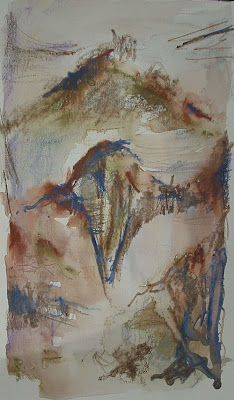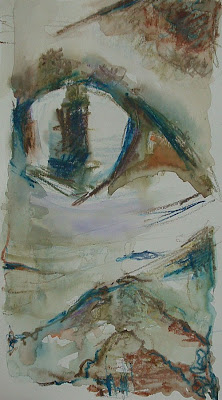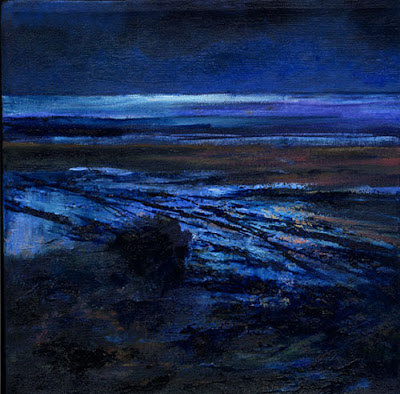the usefulness of sketchbooks and sketching, plein air and in the studio - they can be a source of information for years to come

How do I use sketchbooks?
Using sketchbooks to work out ideas and sketching plein air are very important to me. The plein air sketches are done simply to study scenes or weather or texture or light ....... whatever has grabbed my interest. They aren't intended to be finished pieces for framing, though sometimes they do become finished and are framed. In that case I scan them and keep a print in the sketchbook, part of a series of linked sketches and ideas. The time spent looking intently and studying colour, form, line and light fixes the subject in your memory.
These sketches were of the bark on some birch trees that fascinated me with the multiple 'eyes' in the bark pattern. I had no thoughts at all as to what I would do with the information in the future. When I was sketching it was pure research.
Developing ideas from sketchbooks
Sketches of Trees
At home I looked at the sketches and the idea of some long thin canvasses and abstracted paintings evolved and I made notes about the ideas I had. You can see the finished work that evolved from these and more work on trees here: http://sitekreator.com/vivienb/trees.html
here: http://sitekreator.com/vivienb/landscape_paintings.html ,
here: http://sitekreator.com/vivienb/landscapes_2.html
and here: http://sitekreator.com/vivienb/landscapes_3.html


So, my way of working is to gather lots of research material on a subject that interests me and then work out the possibilities and ideas these spark, rather than have an idea for a painting and look for subjects as photorealists do.
more sketches of trees: http://sitekreator.com/viviensketches/trees.html
Sketches of the Beach

a very very quick sketch, done at the beach as the sun set, with watersoluble Tombo pen and wash (dipping my finger in water to create washes, as my brushes were packed up ready to leave), Vivien Blackburn
The sketch above was a very fast one, done at the end of a day painting with friends. The sun was setting and there wasn't enough light to carry on painting. I just had time for a quick reminder to myself of the light at that moment.
You may wonder what the objects on the beach are - they aren't large rocks but huge steel mesh cages of flint rocks - each rock about a foot or so long and hundreds of them in a cages about 5-6 feet long - that are used as sea defences to protect the dunes
This was one of the memories drawn on to do the studio pieces below amongst others, I didn't want to reproduce the sketch but to combine it with other impressions and produce something new:

 Nightfall at the Beach, Stormy Day, collagraph, Vivien Blackburn
Nightfall at the Beach, Stormy Day, collagraph, Vivien Blackburn
This was one of a series of collagraphs based on this sketch, each one differently inked.
http://sitekreator.com/vivienb/pntings__artists_prints_digital_images.html oil sketches done plein air, the beach in a variety of weathers and seasons.
more sketches of the coast:
http://sitekreator.com/viviensketches/cornwall.html
http://sitekreator.com/viviensketches/coast_2.html
http://sitekreator.com/viviensketches/moleskine_sketchbook.html
http://sitekreator.com/viviensketches/small_coast_sketchbook.html and
http://sitekreator.com/viviensketches/beaches.html
As I've written before, the ideas for the long thin seascapes I do came from the edges I'd cut off when framing these square oil and watercolour sketches done plein air. I stuck them in my sketchbooks because they had the colours of that particular day at that particular time and I liked the sense of time passing that they showed. I don't think that idea would have developed in this way without my sketchbooks. For me they are a really essential part of the way I work and develop ideas.
I can understand how some authors - like Dorothy Dunnett, one of my favourites - say that they enjoy the research phase of writing even more than writing the novel itself. I really like the no-pressure, pure curiosity phase of sketching and working round ideas.
Do you use your sketchbooks this way? how do you use them? do you use them at all?.



Comments
I usually take a box of watercolour pans out - not a minimalist when taking equipment I'm afraid! I rather like my White Knights watercolours for plein air and generally keep the tubes of W&N artists colours for the studio. It had 24 colours in and I added some in the section meant for brushes - so maybe 30!!! I concentrate on a variety of blues - cerulean, ultramarine, indigo, phalo blue, prussian then warm and cool yellows, then reds - alizarin, permanent rose, cadmium and windsor red plus burnt umber, burnt sienna, yellow ochre, viridian (for mixing lovely sea colours or man-made colours)and magenta.
I warned you! NOT a minimalist!
the bare necessities are warm and cold blue, red and yellow plus burnt umber, ochre, magenta, viridian.
I find the colours in the tiny plein air sets too limiting - and the larger box isn't exactly heavy to hold or carry.
I wouldn't of course use all these in one painting! but you never know what colours you'll see. I hate not having the pigments to mix the colours I want quickly and easily.
Without viridian for instance I'd never make the turquoisy greens that you get in the sea - a touch of ochre sometimes and you get the green on a different day. It also mixes beautifully with alizarin to get deep dark burgundies and deep dark forest greens that stay translucent. Magenta and Indigo makes a fabulous dark storm cloud colour.
I also take a tube of white gouache - it's great for mixing with watercolour to regain and lights you lose and rescuing a sketch. Used carefully noone would even notice :)
I take a telescopic waterpot as it takes less room in my bag.
I take coloured pencils (not watercolour, just normal polychromos) to scribble or draw into the wc's
hope this is useful :)
something to sit on too - plastic if you like to sit on the ground keeps you dry (often necessary here!) or a folding stool, or I use a handymans toolbox often, which holds my painting things and then makes a handy seat :)
I should sketch much more - I've got out of the habit, not that I've ever been good about drawing regularly.
Your comment about using sketches from your sketchbook has made me think. I personally think that some of my best work is in the loose sketches that I've done.
I go out sketching in the summer months with friends from my art club and usually enjoy sketching in pen and wash then. I don't aim for a finished or polished effect. At least it gets me outside and drawing! :)
I love that "birch eye view" sketch.
Billie I usually go out specially to sketch when I take the kitchen sink and all! and don't go too far from the car. If I'm walking far I do have to cut back and if it's a non-painting trip then I'd just take a pencil and moleskine. I have arthritis so have to be careful with carrying heavy weights - and asthma so I get breathless as well! (poor old crone!)
Julie I'd call the fabric pieces 'sketches' when they are experimenting and working out :) and I agree that the looseness of sketches often makes them the best work.
Dinah thanks :) - I hope you keep all the doodles! see I'd stick them in the sketch book alongside the other work - my sketchbooks get quite messy with bits stuck in as well as drawings.
love those trees and brushes,looks like your mind is bubbling with great ideas
yes, I've always got more ideas than time to work on them :>(
I enjoy seeing your paintings of Wales
I seriously want a press of my own even if it is small! When I looked at those I've done, I usually work relatively small in print, although monoprints are nice larger.
It's just the intaglio processes that really need a press - though I've read about people using the car - driving over the print!
Ah... see, cars are good for something... don't have one though...